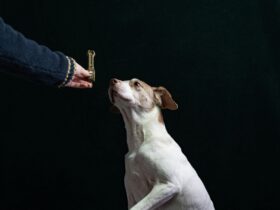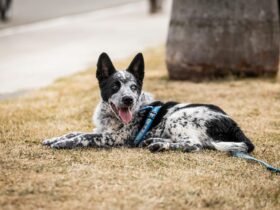The idea of dogs talking might sound like something out of a sci-fi movie, but with advances in training techniques, it’s possible to teach your dog to communicate using buttons. These buttons, which play pre-recorded messages when pressed, can help your dog express their needs, desires, and even emotions. In this guide, we’ll explore how you can teach your dog to talk with buttons, the benefits of this training, and tips to make the process successful.
Understanding the Concept
Before diving into the training process, it’s essential to understand how communication with buttons works:
- What Are Communication Buttons? Communication buttons are devices that play recorded messages when pressed. Each button is programmed with a specific word or phrase, such as “outside,” “play,” or “food.”
- How Do They Help? These buttons allow dogs to express their needs and desires by pressing the buttons that correspond to their wants. Over time, your dog can learn to use these buttons to communicate more effectively.
Benefits of Teaching Your Dog to Use Buttons
Teaching your dog to use communication buttons offers several benefits:
- Enhanced Communication: Buttons help bridge the communication gap between you and your dog, allowing them to express their needs and feelings more clearly.
- Increased Engagement: This training can provide mental stimulation and engage your dog in a new and exciting way.
- Reduced Frustration: Dogs can become frustrated when they can’t communicate their needs. Buttons offer a way to reduce this frustration and improve their overall well-being.
Getting Started: The Basics
Here’s a step-by-step guide to get started with teaching your dog to use communication buttons:
1. Choose the Right Buttons
Select buttons that are durable, easy to press, and have clear, high-quality recordings. Some popular brands include:
- Gospeak: Known for its robust design and ease of use.
- Human-Grade Buttons: Designed for human use but adaptable for dogs.
- DIY Options: You can also create your own buttons using simple recording devices and durable materials.
2. Set Up the Buttons
- Label the Buttons: Clearly label each button with the word or phrase it represents. This helps your dog associate the button with the specific action or need.
- Position the Buttons: Place the buttons in a location where your dog can easily reach them. Start with one or two buttons and gradually add more as your dog becomes familiar with the training.
3. Introduce the Buttons
- Allow Exploration: Let your dog explore the buttons at their own pace. Place treats or favorite toys near the buttons to create a positive association.
- Press and Reward: Gently press the button while saying the word it represents. Reward your dog with a treat and praise when they show interest in the button.
4. Teach Button Use with Positive Reinforcement
- Demonstrate the Action: Press the button and immediately follow up with the corresponding action, such as opening the door when you press the “outside” button. This helps your dog understand that pressing the button leads to a specific outcome.
- Encourage Interaction: Encourage your dog to press the button by guiding their paw or nose towards it. Reward them with treats and praise when they press the button and the desired action occurs.
5. Reinforce Learning
- Consistency is Key: Consistently use the same word or phrase for each button. This helps reinforce the connection between the button press and the action.
- Practice Regularly: Incorporate button use into your daily routine. Practice pressing the buttons and rewarding your dog to strengthen their understanding.
Advanced Training: Expanding Button Use
Once your dog becomes proficient with the initial buttons, you can expand their vocabulary and use of the buttons:
1. Add More Buttons
- Introduce New Buttons Gradually: Add new buttons one at a time to avoid overwhelming your dog. Continue to use positive reinforcement to help them learn the new buttons.
- Label Clearly: Ensure each new button is clearly labeled and placed in a location where your dog can easily access it.
2. Teach Complex Commands
- Combine Buttons: Teach your dog to use multiple buttons in sequence to express more complex needs, such as “play” followed by “ball.”
- Encourage Creativity: Allow your dog to explore different combinations of buttons to express themselves in various ways. Reward them for creative use of the buttons.
3. Monitor and Adjust
- Observe Reactions: Pay attention to how your dog uses the buttons and adjust the training as needed. If they seem confused or frustrated, simplify the training or revisit previous steps.
- Update Vocabulary: As your dog learns to use the buttons effectively, update their vocabulary to include new words or phrases that reflect their evolving needs and preferences.
Troubleshooting Common Issues
During training, you might encounter some challenges. Here’s how to address them:
1. Button Aversion
- Solution: If your dog seems hesitant to use the buttons, ensure they are comfortable and not intimidated by the sound or appearance. Use treats and praise to create a positive association.
2. Inconsistent Button Presses
- Solution: Reinforce button use with consistent rewards. If your dog is inconsistent in pressing the buttons, practice more frequently and ensure that each press is followed by the desired action.
3. Confusion with Commands
- Solution: If your dog seems confused about which button to press, simplify the vocabulary and practice with fewer buttons. Gradually reintroduce more buttons as their understanding improves.
Success Stories and Real-Life Examples
Many pet owners have successfully taught their dogs to use communication buttons. Here are a few examples:
- Panther the Cocker Spaniel: Panther learned to use buttons to ask for walks, playtime, and even specific toys. His owner reported that Panther became more expressive and engaged.
- Lola the Labrador: Lola used buttons to communicate her needs, such as wanting to go outside or asking for water. Her owner found that Lola’s use of buttons reduced frustration and improved their communication.
Conclusion
Teaching your dog to communicate with buttons is a rewarding process that enhances your bond and improves their quality of life. By following the steps outlined in this guide, you can help your dog learn to express their needs and desires more clearly. Remember, patience, consistency, and positive reinforcement are key to successful training. Enjoy the journey of discovering new ways to connect with your furry friend!
Happy training!











Leave a Reply